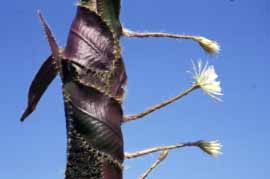
Escontria is a genus of cactus. The only species is Escontria chiotilla, the chiotilla or jiotilla.

Brasiliopuntia is a genus in the cactus family, Cactaceae. It contains only one species, Brasiliopuntia brasiliensis.

Arthrocereus glaziovii is a species of plant in the family Cactaceae. It is endemic to Brazil. Its natural habitat is rocky areas. It is threatened by habitat loss.

Arthrocereus melanurus is a species of plant in the family Cactaceae. It is endemic to Brazil. Its natural habitats are dry savanna and rocky areas. It is threatened largely by habitat loss.

Cleistocactus hyalacanthus is a species of columnar cacti in the genus Cleistocactus. The name comes from the Greek kleistos meaning closed because the flowers hardly open.

Harrisia bonplandii is a species of cactus. The cactus plants in the Gran Chaco are generally called tuna and this specific variety reina de la noche. Fruits and roots are edible and well known to the native nations of the Gran Chaco.

Harrisia pomanensis is a species of cactus.

Gymnocalycium anisitsii is a globular cactus belonging to the family Cactaceae. The specific epithet honors the Hungarian pharmacist Dániel Anisits J. (1856-1911).

Parodia schumanniana is a quite rare species of succulent plant in the family Cactaceae. The specific epithet schumanniana honors the cactus specialist Karl Moritz Schumann.

Soehrensia thelegona is a species of cactus in the Soehrensia genus.

Ferocactus alamosanus is a species of Ferocactus from Mexico.
Frailea gracillima is a species of Frailea from Brazil, Paraguay, and Uruguay.

Praecereus saxicola is a flowering plant in the family Cactaceae that is found in Bolivia, Argentina and Paraguay

Acanthocalycium spiniflorum is a species of flowering plant in the cactus family Cactaceae from Argentina.

Cereus phatnospermus, synonym Cereus kroenleinii, is a species of columnar cactus found in Brazil, Bolivia, and Paraguay.

Strophocactus wittii, synonym Selenicereus wittii, known as the Amazon moonflower, is a species of plant in the genus Strophocactus in the cactus family (Cactaceae), and is one of several species commonly called "moonflowers". It was first described in 1900 and is one of three species of cactus found in the central Amazon basin.

Acanthocalycium rhodotrichum is a species of Acanthocalycium found in Argentina, Bolivia, Brazil, Paraguay, and Uruguay.

Xiquexique gounellei is a species of plant in the genus Xiquexique of the cactus family. Common names include "Alastrado", "Chique-Chique", "Xique-Xique" and "Xique-Xique das Pedras".

Oroya peruviana is a species of cacti, originating from Peru.

Cephalocereus columna-trajani is a species of cactus from Mexico.



















